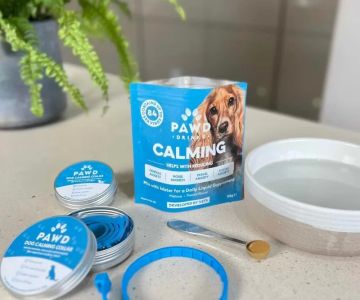Understanding Allergies in Dogs
As a dog owner, I never thought that my furry friend could be affected by allergies. It wasn’t until my dog, Max, started scratching incessantly and developing red patches on his skin that I realized something was wrong. His behavior was strange, and I couldn’t figure out what was causing his discomfort. That's when I learned about the common problem of allergies in dogs. If you’ve noticed similar symptoms in your dog, you're not alone. Dog allergies are more common than we think, and they can affect dogs of all ages, breeds, and sizes. Let me take you through the symptoms, causes, and treatment options available for managing allergies in dogs.
What Are Dog Allergies?
Dog allergies occur when a dog’s immune system reacts abnormally to a substance, commonly referred to as an allergen. The body mistakenly identifies the allergen as harmful, triggering an allergic reaction. This can cause a variety of symptoms, ranging from skin irritation to respiratory issues. Just like humans, dogs can develop allergies to food, environmental factors, and even parasites. It’s essential for pet owners to be aware of the signs of allergies in dogs to prevent them from worsening.
Symptoms of Allergies in Dogs
Recognizing the signs of allergies in dogs can sometimes be tricky, as they may not always be obvious. If your dog starts acting differently, scratching more than usual, or showing other unusual behaviors, it’s worth looking into the possibility of an allergy. Let me share with you some of the most common symptoms I noticed in Max, and these might help you identify if your dog is struggling with allergies:
1. Itchy Skin and Excessive Scratching
It’s often one of the first signs of an allergy in dogs. Max’s scratching was non-stop, and it caused his skin to become raw and irritated. Dogs with allergies will often lick or chew at their paws, legs, and belly to alleviate the itching. It can be heartbreaking to watch your dog suffer from constant discomfort.
2. Red, Inflamed Skin and Hot Spots
As the scratching continued, Max developed hot spots—painful, infected areas on his skin. These red, inflamed patches often occur due to constant irritation or licking. They are a sign that the allergy is affecting the skin and that the immune system is reacting strongly.
3. Runny Eyes and Sneezing
Environmental allergies, like pollen or dust mites, can cause respiratory symptoms in dogs. You may notice watery eyes, frequent sneezing, or even coughing. This was the case with Max, who had a history of seasonal allergies that flared up during certain times of the year.
4. Vomiting and Diarrhea
If your dog’s allergies are food-related, gastrointestinal issues like vomiting or diarrhea may occur. Max had a few incidents where I couldn’t figure out if his upset stomach was due to something he ate or because of his allergy. It’s important to track his symptoms to determine if the two are connected.
Causes of Dog Allergies
Understanding what’s triggering your dog’s allergies is crucial for managing their condition. There are several common causes of allergies in dogs, and each can present unique challenges when it comes to treatment. Let me walk you through the most common culprits:
1. Environmental Allergies
Environmental allergens are one of the most common causes of allergies in dogs. Pollen, dust mites, mold, and even flea saliva can trigger allergic reactions. I remember how Max started itching uncontrollably during the spring months. The pollen count was high, and it seemed like Max’s allergies were particularly sensitive to the seasonal change. Regular baths, keeping him indoors during peak pollen hours, and using allergy medications helped to manage these seasonal flare-ups.
2. Food Allergies
Food allergies are another significant cause of allergic reactions in dogs. Common allergens include beef, chicken, dairy, wheat, and corn. If your dog develops symptoms like vomiting, diarrhea, or skin issues after eating, you may want to investigate their diet. After working with my vet, I discovered that Max was allergic to certain grains, and switching to a grain-free diet greatly improved his condition.
3. Flea Allergies
Flea allergies are more common than you might think. Flea saliva can trigger an allergic reaction, causing intense itching, hair loss, and skin infections. Regular flea prevention is key in managing this type of allergy. Max had a flea allergy, and it took some time to get the right flea control regimen to keep him comfortable.
Treating Allergies in Dogs
Once you’ve identified the source of your dog’s allergies, the next step is to treat them. There are several approaches to managing dog allergies, depending on the severity and the cause of the reaction. Based on my experiences with Max, here are some treatment options I’ve found helpful in managing his allergies:
1. Medications
One of the first treatments my vet suggested was antihistamines. These can help reduce itching and inflammation caused by allergies. In more severe cases, steroids or allergy shots may be recommended. For Max, the antihistamines worked wonders, but it’s essential to consult your vet before starting any medication to ensure it’s appropriate for your dog’s specific needs.
2. Special Diets
If food allergies are suspected, the solution may be as simple as changing your dog’s diet. There are hypoallergenic dog foods designed for dogs with food sensitivities. I had to put Max on a limited-ingredient diet, which helped to reduce the allergic reactions he experienced from certain foods. Switching to a novel protein like lamb or duck was a game-changer for him.
3. Flea Control
For dogs with flea allergies, maintaining a strict flea control regimen is essential. This includes using flea preventatives, regular bathing, and cleaning your home to remove flea eggs and larvae. Max's flea allergy improved once I got serious about using flea control products and kept his environment clean.
4. Allergen Avoidance
Limiting your dog’s exposure to allergens is one of the most effective ways to manage allergies. For environmental allergies, this may involve reducing the time your dog spends outdoors during peak allergy seasons, frequent baths to remove allergens from their fur, and keeping your living spaces clean. For food allergies, it’s vital to avoid the offending ingredients completely.
Why You Should Seek Professional Help
While there are many over-the-counter solutions for managing allergies in dogs, the best course of action is always to consult with a veterinarian. They can help you identify the cause of your dog’s allergies through tests, provide personalized treatment plans, and ensure that your dog stays as comfortable as possible. Max’s journey to managing his allergies was made much easier with the support and guidance of my trusted vet.
If your dog is suffering from allergies, I highly recommend seeking professional help. The right treatment can make all the difference in improving your dog’s quality of life. You can visit us at Hidden Brook Veterinary, where we specialize in allergy care and can help you find the best solutions for your pet’s needs.












